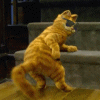|
|
Post by MamIDdau on Oct 31, 2008 11:35:02 GMT
Found this website earlier: www.britannia.com/wales/culture1.htmlAnd I read all about.... Nos Galan Gaeaf (All Hallow's Eve) In addition to preserving the Eisteddfod, the Noson Lawen and the Cymanfa Ganu, Wales has also managed to keep alive other old traditions, though some of these are now confined to particular areas. Many are connected with the old New Year's Eve of Celtic tradition, transformed into the rites connected with the Christian celebration of All Hallow's Eve, or Halloween. In Wales, this night is called Nos Galan Gaeaf (the beginning of the new year), the night when spirits walk abroad. On stiles, or entrances to footpaths, ghosts of dead persons are said to appear at midnight. In some parts of Wales, the ghost was often the Ladi wen (white lady), but in the north, it was usually the more frightening Hwch ddu gwta (tail-less black sow) that appeared. Before dawn, huge bonfires were lit on the hillsides, often two or three within sight of each other. It was a great honor to have your bonfire burn longest and great pains were taken to keep them alight. While apples and potatoes were thrown into the fires for roasting, the watchers would dance around or leap through the flames for good luck. Stones were thrown into the fire; then, when the flames died down, everyone would run for home to escape the clutches of the Hwch ddu gwta. The next morning, at daybreak, searchers would try to find their stones. Those who succeeded would be guaranteed good luck for the coming year. If you could not find your stone, then bad luck or even death would follow. On Nos Galan Gaeaf in Montgomeryshire, in many farmhouses, a mash was made of nine ingredients: potatoes, carrots, turnips, peas, parsnips, leeks, pepper, salt and new milk. In the mash was hidden a wedding ring. The young maidens of the local village would dig into the mash with their wooden spoons, anxious to learn their fate, for the one who found the ring would be first married. In Carmarthenshire, the mash of nine ingredients, stwmp naw rhyw, was not used to foretell the future, but nine girls used to meet to make a pancake containing nine ingredients. This was then divided among the girls and eaten. Before morning, each girl would have a vision of her future husband. In many parts of North Wales, where the custom of bundling was a very common practice (much frowned upon by the English judiciary) the young dreamers would often find their future husband in bed with them!! Along with the mash, or the pancakes, came the wassail bowl. The wassail was often put inside a puzzle jug, with many spouts, and the unsuspecting drinker would find himself doused with beer, wine, or cider by drinking from the wrong spout. Some of these puzzle jugs can now be seen at the National Folk Museum of Wales at St. Ffagan, near Cardiff. The custom is very similar to one observed by the author in southwest Germany, where participants in a contest drank out of a large glass boot that had to be handled a certain way to prevent spillage. Apples always played a large part in Halloween festivities (they are the one fruit that grows prolifically in the temperamental Welsh climate and can be preserved throughout much of the early winter). The most popular game was apple bobbing, with six or eight perfectly round fruit placed in a large bowl of water set on the floor. Then, with both hands tied behind their backs, the young lads and lasses would try to pick up an apple with only their teeth. Usually they received a nose and mouth full of water for their pains, but no apple!! In some houses, the apples were tied on one end of a stick suspended from the ceiling with a candle tied to the other end. The stick was then rotated and the participants, again with their hands tied behind them, tried to catch the apple with their teeth as it spun around. They usually ended up with a mouth full of candle! Apples played a large part in many other customs, too. If you peeled an apple in one single piece and then threw the peel over your shoulder, the letter of the alphabet it most closely resembled when it hit the ground would be the initial letter of your future partner in marriage. Other Halloween customs did not involve apples, but the unseen. In the Vale of Glamorgan, at night, when the spirits were roaming the churchyards, one of the braver villagers would put on his coat and vest inside out and recite the Lord's Prayer backwards as he walked around the church a number of times. Then the courageous lad would enter the porch and put his finger through the keyhole of the church door to prevent any spirits from escaping. It was believed that the apparitions of those who would soon die could be spied through the keyhole. In other areas of Wales, groups of youths would dress up in women's clothes with the girls in men's clothing. They would wander from house to house after dark, chanting verses and soliciting gifts of fruit or nuts, used to divine one's future. In other, more rural areas, young men used to dress up in sheepskins and old ragged clothes and disguise or blacken their faces. After chanting their weird rhymes, they would then be given gifts of apples or nuts, and sometimes beer. The groups would be known as the gwrachod (hags or witches). The visiting of these groups were always in fun, but were taken seriously as harbingers of good tidings for the forthcoming year and the expulsion of the bad spirits from the household. Happy Samhain/New Year xxx |
|

